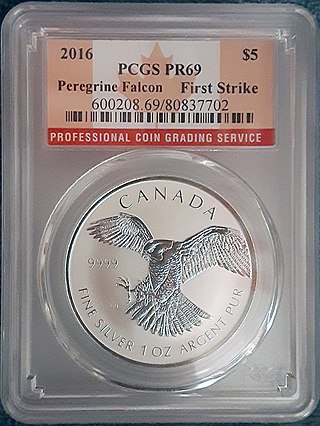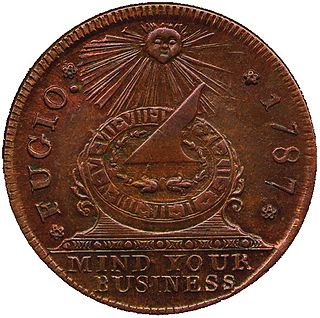
Coin collecting is the collecting of coins or other forms of minted legal tender. Coins of interest to collectors include beautiful, rare, and historically significant pieces. Collectors may be interested, for example, in complete sets of a particular design or denomination, coins that were in circulation for only a brief time, or coins with errors. Coin collecting can be differentiated from numismatics, in that the latter is the systematic study of currency as a whole, though the two disciplines are closely interlinked.

Coin grading is the process of determining the grade or condition of a coin, one of the key factors in determining its collectible value. A coin's grade is generally determined by six criteria: strike, preservation, luster, color, attractiveness, and occasionally the country/state in which it was minted. Several grading systems have been developed. Certification services professionally grade coins for tiered fees.

Notaphily is the study and collection of paper currency, and banknotes. A notaphilist is a collector of banknotes or paper money, particularly as a hobby.

In Canada, a dime is a coin worth ten cents. It has been the physically smallest Canadian coin since 1922; it is smaller even than the country's penny, despite its higher face value. According to the Royal Canadian Mint, the official national term of the coin is the 10-cent piece, but in practice, the term dime predominates in English-speaking Canada. It is nearly identical in size to the American dime. Unlike its American counterpart, the Canadian dime is magnetic due to a distinct metal composition. From 1968 to 2000, it was composed entirely of nickel, and since 2001, it has consisted of a steel core with plating composed of layers of nickel and copper.

In cricket, the toss is the flipping of a coin to determine which captain will have the right to choose whether their team will bat or field at the start of the match.

The Canadian fifty-cent coin is a Canadian coin worth 50 cents. The coin's reverse depicts the coat of arms of Canada. At the opening ceremonies for the Ottawa branch of the Royal Mint, held on January 2, 1908, Governor General Earl Grey struck the Dominion of Canada's first domestically produced coin. It was a silver fifty-cent coin bearing the effigy of King Edward VII.

In Canada, a penny is an out-of-production coin worth one cent, or 1⁄100 of a dollar. According to the Royal Canadian Mint, the official term for the coin is the one-cent piece, but in practice the terms penny and cent predominate. Penny was likely readily adopted because the previous coinage in Canada was the British monetary system, where Canada used British pounds, shillings, and pence as coinage alongside U.S. decimal coins. Like all Canadian coins, the obverse depicts the reigning Canadian monarch at the time of issue.

Professional Coin Grading Service (PCGS) is an American third-party coin grading, authentication, attribution, and encapsulation service founded in 1985. The intent of its seven founding dealers, including the firm's former president David Hall, was to standardize grading. The firm has divisions in Europe and Asia, and is owned by parent company Collectors Universe. PCGS has graded over 42.5 million coins, medals, and tokens valued at over $36 billion.
Numismatic Guaranty Company (NGC) is an international third-party coin grading and certification service based in Sarasota, Florida. It has certified more than 60 million coins. NGC certification consists of authentication, grading, attribution, and encapsulation in clear plastic holders. NGC is a subsidiary of Certified Collectibles Group (CCG), which owns six collectible certification services and is in turn owned by Blackstone, a multibillion-dollar New York City hedge fund.
The Royal Canadian Numismatic Association was founded in 1950. It is a nonprofit association for coin collectors and other people interested in Canadian numismatics. It has members throughout Canada and in other countries. At times, it also works with the Canadian Association for Numismatic Education (CAFNE), an arms length organization, which is defined by the CRA as a Canadian educational and charitable organization. CAFNE provides funding for some of the RCNA's educational seminars and publications.
Third-party grading (TPG) refers to coin grading & banknote grading authentication, attribution, and encapsulation by independent certification services.

The Fugio cent, also known as the Franklin cent, is the first official circulation coin of the United States. Consisting of 0.36 oz (10 g) of copper and minted dated 1787, by some accounts it was designed by Benjamin Franklin. Its design is very similar to Franklin's 1776 Continental Currency dollar coin that was produced in pattern pieces as potential Continental currency but was never circulated.
Certified Acceptance Corporation (CAC) is a Far Hills, New Jersey third-party coin certification company started in 2007 by coin dealer John Albanese. The firm evaluates certain numismatically valuable U.S. coins already certified by Numismatic Guaranty Corporation (NGC) or Professional Coin Grading Service (PCGS).

The Sheldon Coin Grading Scale is a 70-point coin grading scale used in the numismatic assessment of a coin's quality. The American Numismatic Association based its Official ANA Grading Standards in large part on the Sheldon scale. The scale was created by William Herbert Sheldon.

The Louisiana Purchase Exposition gold dollar is a commemorative coin issue dated 1903. Struck in two varieties, the coins were designed by United States Bureau of the Mint Chief Engraver Charles E. Barber. The pieces were issued to commemorate the Louisiana Purchase Exposition held in 1904 in St. Louis; one variety depicted former president Thomas Jefferson, and the other, the recently assassinated president William McKinley. Although not the first American commemorative coins, they were the first in gold.
The Coin of the Year Award (COTY) is an awards program founded and annually conducted by the American publisher Krause Publications of Iola, Wisconsin, and directed at the coin producing industry. Awards are given for numismatic design, artistic vision and craftsmanship. A panel of international judges chooses the coins from those issued two years prior to the year of the award.

Coin cleaning is the controversial process of removing undesirable substances from a coin's surface in order to make it more attractive to potential buyers. The subject is disputed among the numismatic community whether cleaning coins is necessary. Those that argue in favor of cleaning are also in dispute on which methods work best. It was once common practice to clean coins as the method was recommended by experts in the field. Solutions from pencil erasers to wire brushes and potassium cyanide were all used as cleaning agents with the goal to make the coin look brilliant again. When certified grading came into use in the mid 1980s though, the practice of cleaning coins diminished over time. Most coin experts have since come out against cleaning coins, as doing so can negatively affect them both in grade and value. If a potentially valuable coin must be cleaned then professional work is recommended. Commonly found coins are mentioned as ideal candidates for any attempted cleaning experiments.
The American Numismatic Association Certification Service, better known as ANACS, is a coin grading company founded in 1972.

Coin slab is a type of holder for a coin. Slabbed coins are typically from one of the coin grading companies. The practice of sending coins to third-party grading companies and then "slabbing" them began in 1986.















